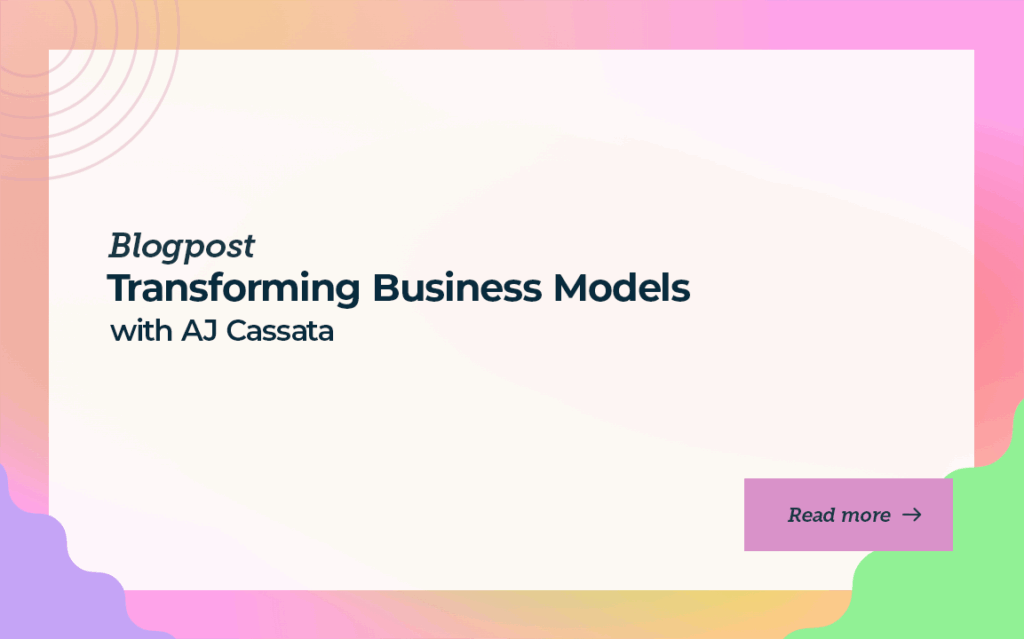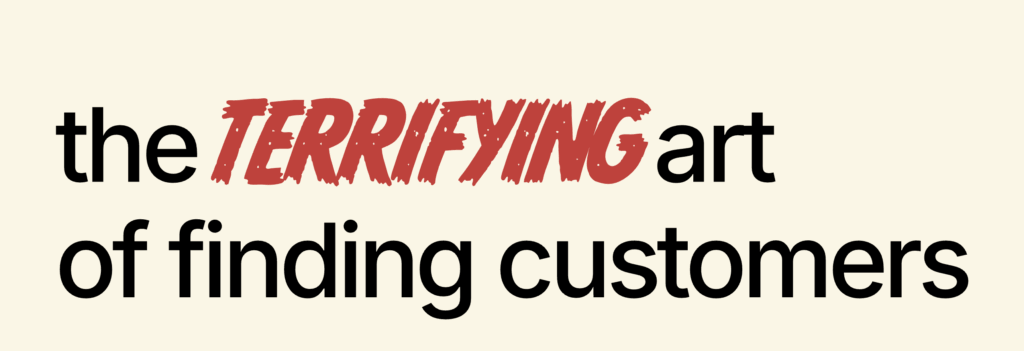Transforming Business Models with AJ Cassata

They tried to brute-force growth, more leads, more sequences, more hustle. It didn’t stick. In this Predictable Revenue podcast, AJ Cassata sat down with host Collin Stewart to unpack why the model was wrong.
AJ’s pivot from coaching to done-for-you (DFY) tightened outcomes, stabilized onboarding, and made automation + AI actually compound.
This post distills that conversation into a founder’s playbook: fix fit, productize the win, automate the boring, personalize the critical, and measure with LTV/CAC and retention. If growth feels heavy, it’s not a pipeline issue. It’s a model issue.
The “Forcing It” Moment
“I realized I was kind of like forcing things.”
That’s the line that stops you. Not a pipeline problem. A model problem.
If you’re stacking more cold email, more automation, more hustle, and growth still feels heavy, you’re likely forcing fit. In AJ Cassata’s case, the coaching model made acquisition loud and delivery fragile. Every new client added variability. Outcomes swung. Margins flattened. The team ran harder but not smarter.
Here’s how “forcing it” shows up:
- Stagnant margins: Revenue up, profit sideways. Discounts creep in. Scope stretches.
- Founder-driven heroics: Deals close because you jump in. You’re the glue, and the bottleneck.
- Inconsistent outcomes: Client wins feel random. Onboarding and delivery aren’t repeatable.
If these symptoms sound familiar, adding more leads won’t fix it. You need a model that makes outcomes predictable. That usually means tightening the offer, standardizing delivery, and swapping clever hacks for a clean system. Only then do automation and AI amplify the right things, speed, not chaos.
Why the Model Matters
Coaching sells ideas. DFY sells outcomes. When you own the work, you control the levers, tools, timelines, QA, and the sequence that creates results. That control turns “hope the client implements” into “we implement,” which tightens variance and raises win rates.
Why DFY wins for scale:
- Outcome control: You set the playbook, run the steps, and QA the output. Less client drift, fewer surprises.
- Recurring revenue: Scope becomes a package (e.g., monthly outreach, reporting, and optimization). Predictable work → predictable cash flow.
- Operational learnings compound: Each cycle hardens the SOPs. The system gets faster and cheaper with every client.
Think of product-market fit as a spectrum, not a switch. Weak fit amplifies noise. More leads create more chaos. Stronger fit multiplies GTM: the same campaign, same budget, better conversion and retention.
What changes when you shift to DFY:
- Offer: From “we teach you outreach” → “we own your outbound pipeline, 10–20 targeted meetings/month.”
- Delivery: From ad-hoc templates → a 5-step sprint: research → relevance hooks → multi-channel send → QA → iterate.
- Metrics: From “sessions attended” → “meetings booked, SQLs created, payback in ≤3 months.”
Result: better PMF signal, cleaner ops, and revenue you can forecast. Once fit tightens, automation and AI start compounding the right things, leading to consistent outcomes.
Automate the Boring, Personalize the Critical
Automation should clear the path. Personalization should earn the reply. Don’t mix them up.
What to automate (every time):
- Lead routing: Auto-assign by ICP segment, industry, or territory. Kill the manual spreadsheet.
- Follow-ups: Pre-schedule 3–5 touches with logic (opened, clicked, no-reply). Keep cadence steady.
- Onboarding steps: Auto-create kickoff docs, tasks, timelines, and a 14-day “first win” milestone.
- Reporting: Pull meeting counts, conversion, and channel ROI into a weekly snapshot, no human wrangling.
Where to personalize (where it pays):
- Relevance over fluff: Use one tight hook that proves you did the homework, recent funding, tech stack, hiring push, or a live campaign they’re running.
- Cold email rule: 1 line of context + 1 specific outcome + 1 simple ask. Example: “Saw you’re hiring 3 AEs and running HubSpot. We book 10–15 meetings/mo with relevance-led outbound for seed–Series A teams. Worth a 12-minute call Tuesday?”
- LinkedIn rule: Comment with substance on a post, then send a short DM that references it. No paragraphs. No pitch dump.
Foundational plays (ship these before any sequence):
- Clear ICP: Industry, company size, tech, and trigger events. If the list is fuzzy, everything downstream breaks.
- Offer clarity: Name the outcome (“qualified meetings”), the mechanism, and the boundary (SLO/scope).
- Tight calendars: 15-minute intro slots, time-zone aware, auto-reminders.
- Short forms: Only fields you actually use. Fewer inputs → higher conversion.
Tooling note: Let AI draft variants, summarize research, and QA tone, but a human sets the relevance hook and approves the send. Automation gives you speed. Personalization wins the meeting.
AI’s Real Role in Sales (Today)
“AI can assist in writing but needs human oversight.”
Treat AI as a speed boost, not a substitute for judgment. It’s great at drafts and data. It’s weak at context, nuance, and tradeoffs.
Use cases that work right now:
- Draft → human edit: Have AI produce first-pass emails, sequences, and call outlines. A rep tightens the hook, checks facts, and cuts fluff before sending.
- Research → rep insights: Feed AI a prospect list with signals (funding, tech stack, hiring). Get a one-page brief with 2–3 relevance angles per account.
- QA for tone and clarity: Run final copy through AI to flag jargon, long sentences, and mismatched tone; keep the decision with a human.
Hard limits (today):
- Not an autonomous SDR: AI can’t own quota, judgment, or complex objections. It misses context and overconfidently invents facts.
- Personalization still requires people: The one sentence that proves you understand the buyer’s world, the part that earns replies, comes from a human.
- Evaluate before replacing: Pilot in a narrow lane (e.g., research summaries for one segment). Measure reply rate, meeting rate, and error rate before expanding.
Bottom line: let AI handle volume work and quality checks. Keep humans on relevance, negotiation, and accountability. That mix raises throughput without tanking trust.
Balance the System: Acquisition vs. Fulfillment
More leads don’t fix a shaky engine. If kickoffs slip, “first value” arrives late, or your team is firefighting, treat acquisition like a valve, not a firehose. Close it a notch. Tighten ICP, raise qualification, and shift reps to stabilize delivery. You won’t lose momentum, you’ll protect it.
Onboarding is where promises turn into workflow.
Make the first two weeks show real progress: a qualified meeting on the calendar, a clean dashboard, and a campaign the client can show their CEO. That early win buys trust and time.
Use a few SLOs as a shared scoreboard: kickoff within five business days, first qualified meeting within 14, responses within one. Publish them. Review weekly. When you miss, explain why and fix the root cause. Credibility compounds faster than case studies.
If margins sag or quality drifts, run a short stabilization sprint. Simplify scopes, clean handoffs, and clarify ownership. Counterintuitively, slowing the top of the funnel can speed growth, because predictable delivery lifts retention and expansion. Acquisition feeds the machine. Fulfillment proves it deserves to eat.
Measure What Matters: LTV: CAC and Retention
Choppy growth = fuzzy math. Lock two numbers and steer by them.
Targets first. Set payback and defend it. Example: CAC back in ≤3 months. At $1,500/mo with 70% gross margin, you get ~$3,150 to acquire and onboard (3 × $1,050). That cap sets outreach volume, pricing, and discounts.
Let CAC be the throttle. Work backward from reply → meeting → close. If one client takes ~600 emails and the fully loaded cost blows past $3,150, don’t add volume, fix fit, lists, or the offer. Outreach is a cost until payback is proven.
Make LTV earned, not assumed. Anchor it to retention and expansion you can actually deliver; assume conservative churn.
Build retention (three moves):
- Success milestones: Day 14 first qualified meeting; Day 30 meeting→SQL >30%; Month 2 = 10–15 qualified meetings. Hit them and state it.
- Quarterly reviews: Promise vs. delivered → decide what changes. Leave with one upgrade.
- Expansion triggers: Pre-agree signals (full calendars, >80% show, new segment) so upsell feels inevitable, not pushy.
With dependable LTV and disciplined CAC, you know exactly how hard to push acquisition, because the payback math tells you.
Your Next Three Moves (Playbook)
1) Audit fit: Where are you forcing it? Follow the friction. Deals that only close when you jump in. Clients who need custom work to see value. “First value” arriving late. List the patterns and decide what you’ll stop selling. If the model needs heroics, it’s a misfit, not a marketing problem.
2) Rebuild the offer for recurring value. Define the Minimum Delightful Outcome. The smallest, repeatable win a client will gladly pay for monthly (e.g., “10–15 qualified meetings with ICP X”). Package the work around that: scope, cadence, SLOs, and a 14-day first win. Strip everything that doesn’t drive that outcome. Price to hit payback in ≤3 months.
3) Systematize: people → process → tech. Assign clear owners first. Document the path to the MDO second. Then add tools to speed up what already works. Example: researcher owns account signals → SDR crafts one relevance line → sender launches sequence → weekly review closes the loop. Automate handoffs and reporting; keep humans on judgment and personalization.
Do these in order. Fit reduces chaos. A tight offer makes value obvious. Systems turn it into throughput. Only then do automation and AI compound.
Conclusion
Scale follows fit. Nail the minimum delightful outcome, wire delivery to hit it fast, then let automation and AI speed what already works. When LTV is dependable and CAC is disciplined, growth gets easier, because the math does the pushing.
Connect with AJ Cassata to talk DFY outbound and retention plays.
Reach out to Collin Stewart for GTM strategy and sales development ideas.
Let’s diagnose your fit, funnel, and payback.
NO TIME TO READ?



